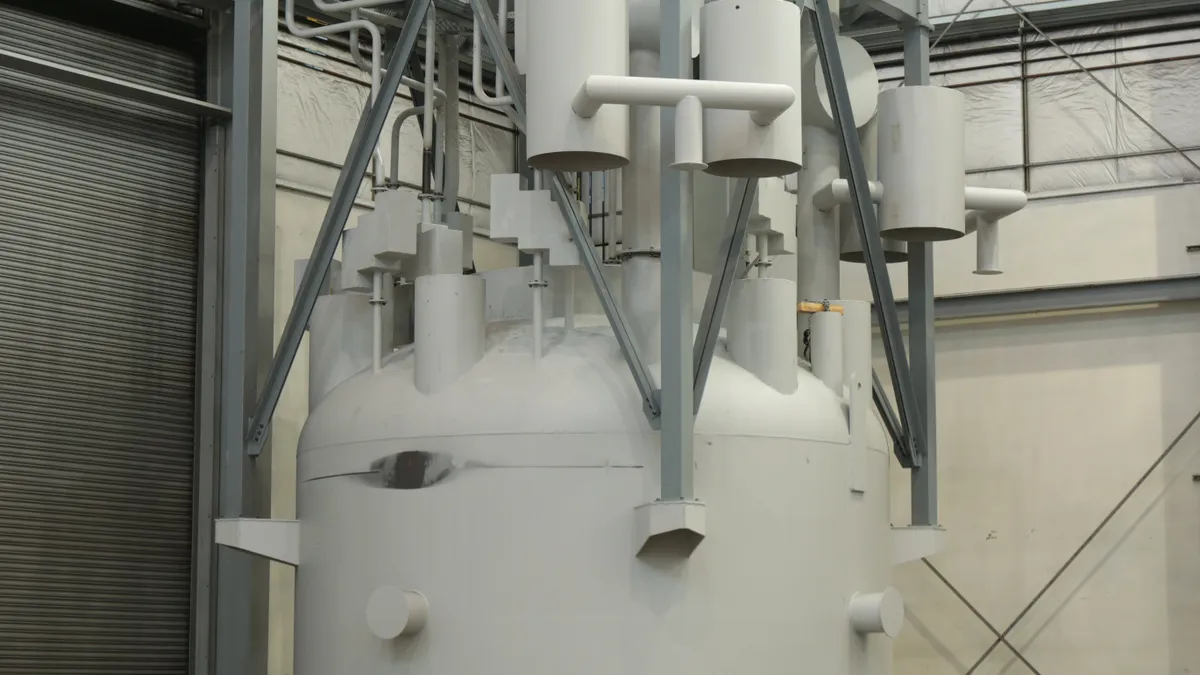Dive Brief:
- The U.S. Nuclear Regulatory Commission is considering whether or not to create a streamlined environmental review process for "advanced nuclear reactor" designs, including those that are based on technology fundamentally different from any U.S. power reactors licensed to operate today.
- Several Republican senators have called upon the NRC to develop this process, saying it is necessary for innovation in the nuclear industry, and would deliver on changes to nuclear regulation recently passed by Congress and signed by President Trump.
- Developers of these advanced reactor designs purport that they have the potential to become significantly cheaper to build and operate than existing designs. In some cases, the developers claim their reactors also can be better matches for a grid shifting toward distributed and renewable energy.
Dive Insight:
The NRC is asking for public and stakeholder input on the potential environmental effects of advanced nuclear reactor designs in order to decide if the agency should create a "generic environmental impact statement", or GEIS, for advanced reactors, according to a notice published in the Nov. 15 Federal Register.
Already used for the relicensing of operating power reactors, the "generic" statement would determine the degree to which regulators can approve environmental impacts across proposed reactors, rather than reviewing all of the environmental impacts of each application. This change could potentially spare proposals for new types of reactors from additional review and speed up their approval process.
Developing an advanced reactor GEIS "will reduce cumbersome regulatory barriers, expedite the environmental review process, and enable market deployment of innovative nuclear technologies," Sens. John Barrasso, R-Wyo., and Mike Braun, R-Ind., said in a June letter to NRC Chairman Kristine Svinicki.
Svinicki responded in July that the NRC was holding meetings about the subject and that "if the staff’s near-term assessment of the viability of preparing a GEIS justifies further effort, the agency will develop a schedule for the project and then initiate efforts to prepare the GEIS." Now, the NRC plans to hold two public meetings in November and a workshop in December to get information "to inform its decision on whether to proceed with the development of a [GEIS] for the construction and operation of advanced nuclear reactors," the Federal Register notice said.
Part of this investigation will be to determine exactly which advanced reactor technologies should be within the scope of a GEIS.
The NRC has several advanced reactor designs that are in varying states of "pre-application" review. For example, Terrestrial Power is developing an Integral Molten Salt Reactor that uses a liquid salt as coolant rather than the large amounts of water used to cool the light water reactors that operate today.
Terrestrial Power claims this design allows for a smaller site footprint and the ability to more efficiently ramp up or down compared to conventional reactors. As a result, the molten salt reactor can be a "clean power partner for variable renewables" by quickly adjusting output in response to the intermittency of wind and solar, according to the company.
An example of a different type of advanced reactor is X-energy's XE-100 reactor, which is helium-cooled. X-energy also says its reactors are low-cost due to "small size" and "modular construction."
Although they depend on different technology, advanced reactor designs share similarities that may lead regulators to standard conclusions about certain environmental impacts, Kati Austgen, the senior project manager for new reactors at the Nuclear Energy Institute (NEI), the trade organization for the nuclear industry, told Utility Dive.
Reactors that have the same site footprint, regardless of the technology, may be found to have the same impact on wetlands, or reactors that do not use water for cooling could be treated as all having the same kind of water impact, Austgen said.
This January, President Trump signed the Nuclear Energy Innovation and Modernization Act (NEIMA) into law. The bill, introduced by Sen. Barrasso, directs the NRC to complete a "technology-inclusive licensing framework for optional use by advanced reactor designers by 2027," as NEI describes it.
A GEIS would be "another important action that aligns with NEIMA’s advanced nuclear reactor requirements," Barrasso and Braun said in their June letter.













